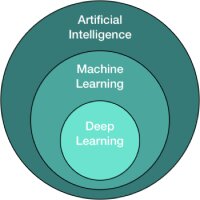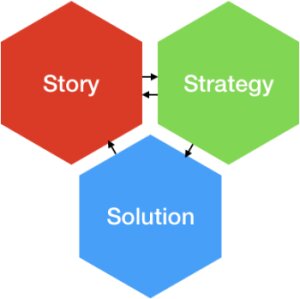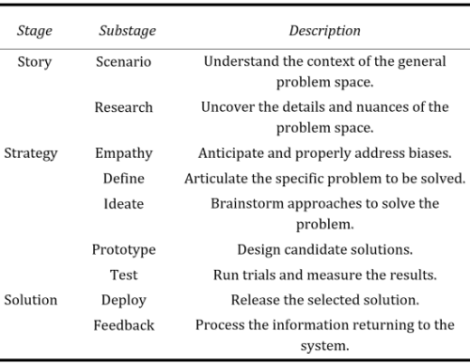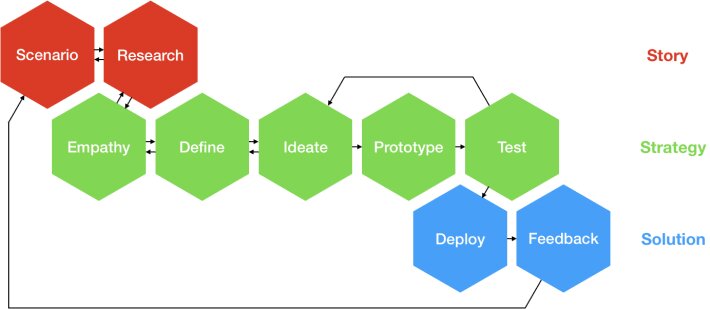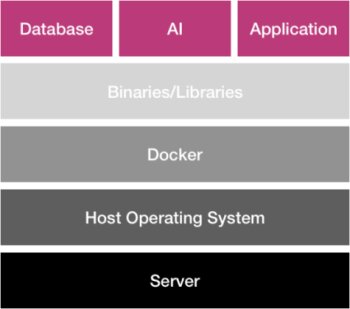Abstract"I have been impressed with the urgency of doing. Knowing is not enough; we must apply. Being willing is not enough; we must do. "
Leonardo da Vinci
A gap has emerged in teaching artificial intelligence (AI) in business education, where a style of curriculum based on strategy is missing. This article presents a new framework, the 3S Process, as a method for teaching leaders how to strategically adopt AI within their organizations. At a high-level, the 3S Process consists of three stages (Story, Strategy, and Solution), which are described in detail in the article. Stage 1: Story in the process is inspired by the Harvard Case Method to provide context for a problem. Stage 2: Strategy uses Design Thinking to produce candidate solutions. The substage of Empathy in Design Thinking plays a crucial role to reduce bias in designing AI. Virtualization technology is a tool for students to experience hands-on learning in prototype development. Stage 3: Solution is where students advocate for their conceptual AI solution in the context of the case study. AI is a type of complex system; therefore, students should consider feedback loops and the potential for unintended biases to enter a deployed solution. The presentation of the 3S Process in this article is conceptual. Further empirical studies, including evaluations of the 3S Process in classroom settings, will be considered in the future.
Introduction
There is a growing interest in teaching artificial intelligence (AI) and machine learning (ML) in business schools around the world (S.-W., 2018). However, an acclaimed approach to teaching AI (Figure 1) in the context of business, especially in terms of entrepreneurship, remains elusive.
Based on the author’s experience working with numerous corporations of varying size, current Master of Business Administration (MBA) programs that include AI can be grouped according to three styles of curricula:
A fourth style based on strategy is missing from approaches to business education. How should leaders be educated in strategically adopting AI/ML in their organizations, and within their products and services (Stachowicz-Stanusch & Wolfgang, 2019)? Watkins writes, “A business strategy is a set of guiding principles that, when communicated and adopted in the organization, generates a desired pattern of decision making” (2007). To glean the most from AI, it should be adopted strategically in organizations to solve business problems (and not just be another piece of technology), in order to garner exponential benefits overtime. The goal of this article is to provide a significant step towards addressing these problems by providing a new framework for a strategy-based approach, referred to as the 3S Process (Bhalla, 2019).
At a high-level, the 3S Process consists of story, strategy, and solution (Figure 2). The 3S Process is inspired by the Harvard Case Method (Rebeiz, 2011) and the approach of Design Thinking (Brown, 2009). The case method provides the context for an example problem, and Design Thinking provides a strategic process for developing a considered solution. Design Thinking has been shown as an effective tool in business education, and in particular, in entrepreneurship education (Brown & Katz, 2011).
Methodology
One of the aims of this work is to understand how to develop AI/ML in order to innovate products and services, and ultimately grow organizations. The 3S Process is the result of codifying the author’s experience in teaching technical, graduate-level courses in AI and ML (in computer science departments at universities), and the author’s experience in consulting with business and technical leaders (C-suite executives) in small to medium enterprises (SMEs). It was observed that although many organizations wanted to adopt AI, it was not clear to them how to adopt AI. This observation fits with a survey of thousands of executives about how their companies use AI, and the data shows that only 8% of firms engage in core practices to support widespread adoption of AI (Fountaine et al., 2019). The author’s objective was to devise a step-by-step process, which was based on commonly known educational techniques and strategic practices, to enable delivery of an approachable framework.
Framework: The 3S Process
Stage 1: Story is based on the Harvard Case Method. Broadly, there are four types of case situations (Ellet, 2007):
For the purposes of the 3S Process, only case types of problems are considered (since other case types are not applicable). The intention of using a case method is to set the context of the problem to be solved. Harvard Business School (HBS) is in the midst of creating their own set of AI cases (Kenny, 2018). It will be interesting to see how HBS frames their AI cases (as well as other business schools that use case methods), and if/how the AI cases extend beyond typical problems.
Stage 2: Strategy is inspired by the approach of Design Thinking. Design Thinking was originally conceptualized for the design of physical products (Brown, 2008). Over time, Design Thinking has been applied not just to the field of industrial design, but to several others also, including the design of businesses themselves (Martin, 2009). Since its inception, there have been many variations and extensions to Design Thinking, each suited to a specific type of problem (Tschimmel, 2012). In this work, the original description of Design Thinking is used, which has five phases:
Stage 3: Solution is the result of the Design Thinking approach within the context of a specific story. It is important to note that arriving at a solution is in actuality building an AI system (Meadows, 2008), which is integrated into another product or service. The performance, or even the behaviour itself, of the system may change with use, for example, the collection and variation of data over time.
To navigate through the framework, the 3S Process is subdivided into nine substages (Figure 3). The graph, with substages as nodes and with transitions from one substage to another as directed edges, represents common paths through the 3S Process. The connectivity (traversals through the graph) should be adapted to the problem to be solved. Table 1 provides a high-level description for each of the nine substages.
Table 1. Description of the nine substages of the 3S Process
Stage 1: Story – Scenario
A case study, provided by educators to students, establishes the context of the problem space. Equally as important, the case study is the basis for discussion between students and educators.
Stage 1: Story – Research
Conduct research to better understand the problem space. What are the important details regarding the problem? What aspects of the problem space can be ignored? Narrow the scope of the problem, focus.
Stage 2: Strategy – Empathy
Understand the potential biases, for example, training data, particular algorithms, and potential users. Examine the problem from multiple opposing viewpoints (Martin, 2009). What are the privacy and security concerns?
Stage 2: Strategy – Define
What exactly is the problem to be solved? Define a set of quantitative/qualitative metrics to measure the success of a solution for solving the problem.
Stage 2: Strategy – Ideate
Brainstorm several candidate solutions. What are the available resources (for example, data and infrastructure)? If a full, candidate solution cannot be implemented as a prototype in a classroom setting, can a subset of the problem be addressed?
Stage 2: Strategy – Prototype
Ideally, a prototype should be designed quickly and implemented efficiently. Fast prototyping leads to the possibility for a greater number of iterations of the Ideate-Prototype-Test cycle.
Stage 2: Strategy – Test
Perform quantitative and qualitative measurements to evaluate the level of success of the candidate solution. If possible, compare the candidate solution to other solutions that were tested previously, and compare to other solutions in the market (or discussed in the case study).
Stage 3: Solution – Deploy
In the context of the case study, make persuasive arguments for the reasoning behind the selected solution. How would the adoption of the selected solution be marketed externally of the organization, or sold internally within the organization? How would the performance of the selected AI system be monitored over time?
Stage 3: Solution – Feedback
How will the transition from training data to continuous data be managed? What derived data can be realized?
Important Features of the Framework
There are three important features of this framework. First, the step of Empathy in Design Thinking is used to help address ethical issues when developing and deploying an AI solution. Second, a software stack using virtualization technology is discussed for how AI prototypes can be developed in practice. Third, complex systems are examined, since even a simple set of rules and algorithms can lead to unpredictable results. Complexity is an important, but often ignored aspect of AI, which is ultimately the pursuit of designing a complex system that displays agency.
Empathy
One of the greatest aspects to Design Thinking is in the phase Empathy. The ability for a designer to empathize with the end customer (and other stakeholders in the design-production-consumption process) for a product in the context of its environment leads to more human-centric and sustainable solutions. In the 3S Process, the designer is to be empathetic to reduce bias in the end solutions, be it for human-to-machine or machine-to-machine interfaces.
For example, Microsoft Inc. released Tay, a chat-bot, in March 2016 (Johnston, 2017). Tay used Twitter as the interface to converse with humans. By people posting offensive Tweets to Tay, the chat-bot quickly learned and then started to post its own inflammatory Tweets. Tay was taken down after only 16 hours of public operation. By employing the stage of Empathy to this research project, the developers could have anticipated the possibility of such an outcome and could have added measures to their AI chat-bot to mitigate bias.
Virtualization
While Stage 1: Story, with the case method at its core, is purely an intellectual exercise, Stage 2: Strategy offers the opportunity for learning through practical examples and exercises with software. It would be difficult, if not impossible due to time constraints, for students (for example, in an MBA course on AI) to implement a full-fledged AI system in the context of solving a case study problem. Instead, the emphasis should be on implementing a solution that addresses a subproblem, as a way to gain experience in AI through hands-on learning.
Virtualization software, for example, Docker (Boettiger, 2015), can be used as part of the Ideate-Prototype-Test substages of the 3S Process. Docker performs operating-system-level virtualization and runs software packages referred to as containers. Containers are isolated from each other and bundle their own application, tools, libraries, and configuration files. Containers can communicate with each other using specific channels and message passing. Docker works with operating systems that run on desktop personal computers and servers. Therefore, the focus here can be thought of as AI running in the cloud and not at the edge (that is, embedded AI).
The idea here is that educators develop software that is built on top of virtualization technology (Figure 4), thus allowing students to focus on the code, algorithms, and concepts needed to build prototypes to address specific subproblems. Depending on the technical know-how of the students, they could work at a high-level (that is, determining effects based on adjusting parameters), at a low-level (write the code for specific algorithms), or somewhere in between these two positions.
There are five advantages to using virtualization software from an educational perspective.
Furthermore, developing web services offer the opportunity to integrate with other cloud services (for example, Amazon Web Services, Microsoft Azure, Google Cloud, IBM Watson), through application programming interfaces (APIs), resulting in faster prototyping, access to pre-trained AI models, and continuously receiving new capabilities. Interoperability between web services based on virtual containers is one of the best methods to realize powerful, complex AI systems today.
Complexity
Stage 1: Story is based on the Harvard Case Method to provide context to a problem space, and Stage 2: Strategy uses Design Thinking and virtualization to develop practical prototypes to address subproblems. Stage 3: Solution completes the 3S Process. Since it is not reasonable for students to implement a production-ready AI system in a classroom setting, the best practice would be for students to develop persuasive arguments for their particular, conceptual solutions, and try to anticipate unintended consequences. Unexpected behaviour can occur in AI due to it being a type of complex system.
Mitchell defined a “complex system” this way: “A system in which large networks of components with no central control and simple rules of operation give rise to complex collective behaviour, sophisticated information processing, and adaptation via learning or evolution.” (2009)
Information returning to an AI system can be considered as either as a positive feedback loop (amplification) or a negative feedback loop (dampening). It is critical to understand the information returning to the system, the correct method to process the information, and the best practice to store the information. For example, unexpected feedback changed the behaviour of the chat-bot Tay, as discussed previously.
Conclusion
To summarize, this article presents a new framework, the 3S Process, for teaching AI in the context of business education. Stage 1: Story uses the Harvard case method to set the context of the problem space. Students are expected to engage in discussion to further understand the problem at hand, to uncover details and narrow the scope of the problem space. Stage 2: Strategy is based on the approach of Design Thinking to develop a prototype, which for practical purposes in a classroom setting addresses a subproblem unveiled in the case study. Particular emphasis is placed on the substage of Empathy to reduce potential biases in the final AI system. Furthermore, virtualization software can be used to create practical candidate solutions, and thus provide a hands-on learning opportunity for the Ideate-Prototype-Test substage cycle. Stage 3: Solution is where students advocate for their conceptual AI solution in the context of the case study and describe their Design Thinking thought process to reach their AI solution. Students should remember that AI is a type of complex system and postulate potential feedback loops, while taking into account the potential for unintended biases to enter the system.
When educators use the 3S Process the expectation should not be that business students develop a deep, technical understanding of AI. Instead, the hope is that the 3S Process provides students with critical thinking and hands-on experience with AI, so that they can make more informed strategic decisions about AI as leaders in their future organization and as part of teams. Business education using the 3S Process can equip leaders with common language and understating regarding AI, thereby improving communication between management and technical experts.
It should be noted that the 3S Process can be adapted from use in education to be applied to entrepreneurship. Instead of using a case study, Stage 1: Story is based on the business problem to be solved and context is provided by market realities. Instead of addressing a subproblem, Stage 2: Strategy directly addresses the business problem. As with the education case, leaders should be aware of bias in the business case as well. The use of virtualization software at this stage has a real benefit, as it can be transferred with ease to production, Stage 3: Solution, particularly for cloud services. Leaders will have to sell their solutions internally within their organization and measure external market response. Complexity will still play a factor and require leaders to continually monitor the performance of their AI system.
Finally, the 3S Process is a complex network itself. The author’s intent is that leaders can leverage the 3S Process, and that the resulting collective behaviour will lead to the emergence of creative thinking around integrating AI in business.
Acknowledgements
Many thanks to the two anonymous reviewers & TIM Review editors for their valuable feedback.
References
Keywords: 3S Process, artificial intelligence, Business Education, design thinking, Harvard Case Method

